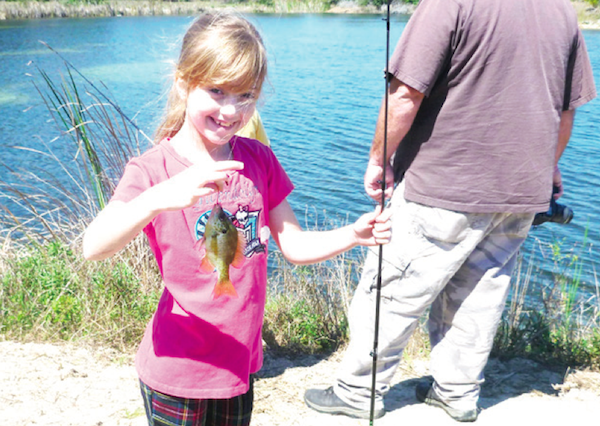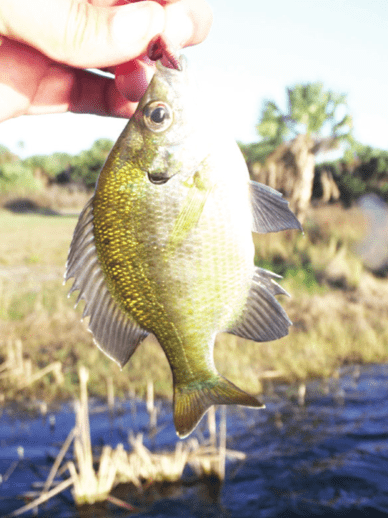I can remember my first fish. I was four years old at the time and we were at a pond near my aunt and uncle’s house. My cousin Dave threw a worm into the water. As the wiggling invertebrate sank a shadow rose up off the bottom and the worm disappeared. The next worm in the water had a hook in it and soon I caught my first fish, a bluegill.
Bream is a collective name for a number of panfish species which include bluegill, redear sunfish (shellcracker), redbreast sunfish, spotted sunfish (stumpknocker) and warmouth. Bream just may be the ultimate kid friendly fish. They’re readily available, abundant, relatively easy to catch and are spunky fighters but are small enough kids can reel them in without help from an adult. No matter where you live in central Florida there is a good chance there is a decent bream fishing spot nearby. They can be found in ponds, lakes, creeks, rivers, canals and just about any body of fresh water that maintains a depth of at least a few feet year-round. Wherever they live, bream will usually be found near some kind of cover like weeds, brush, logs or dock pilings.
Bream certainly aren’t elitist. You can chase them on a $500 fly rod if you want but you can be just as successful with a $5 cane pole. A light spinning or spincast rod and reel spooled with two to
eight pound test line is perfect for bream. Monofilament is more forgiving than braid for kids because it is less likely to snarl itself into impossible, trip killing tangles.
There are a lot of ways to rig up for bream fishing but in most situations it is hard to beat a simple float rig. Tie a small hook to your line and attach a bobber about 18 inches above the hook. There is no magic formula for 18 inches so you should be ready to adjust the bobber shallower or deeper if you are not getting bites. Bobbers should be on the small side, no bigger than a quarter. Many folks like to pinch a small split shot or two about a foot above the hooks to help the bait get down but others like to forego the split shot arguing the lack of extra hardware on the line and the more natural descent of the bait fools the bigger, warier bream.
Bream have small mouths so hooks should be in the #8 to #4 size range with #6 being the best all-around choice. Tru- Turn, which is one of the most popular line of fish hooks among panfish anglers, sells more #6 Aberdeen Panfish hooks than any other size or model in their inventory. Light wire hooks like the Tru- Turn are preferred so if you get snagged, a strong pull on the line will straighten the hook instead of breaking the line. It is also recommended you use a long shank hook that gives you some extra hook shank to grab with your pliers when removing a buried hook from the tiny mouth of a bream.
One good thing about bream is they are not picky about what they eat. They will consume just about anything they can fit in their tiny mouths. When I was a kid all we needed for a good afternoon of bream fishing was a few slices of bread. First chum up the bream by tossing a couple pieces of bread on the water. If that doesn’t peak their interest then smack a few pieces of wet bread onto the water so they break up and sink. For bait pinch off a small piece of bread and knead it into a pea sized ball around the point of the hook.
Rolling a proper dough ball, one that will stay on the hook is a bit of an art form. If the bite slows down you can usually turn the fish back on by throwing a few more pieces of bread “chum” on the water. Bread is great bait for bream, but if you are fishing a pond with resident ducks, skip the bread chumming because you’ll end up feeding the ducks instead of the fish.
Of course there are plenty of other good baits for bream. Worms and crickets are classic panfish baits. I’m a big fan of grasshoppers because a quick stroll through the grass usually offers a ready supply of baits. In fact, just about any insect you have the nerve to grab and pin on a hook will catch bream. If you bring a dipnet and run it through the weeds you can usually catch a good supply of grass shrimp, another excellent bream bait.
Bream will also readily strike lures. Small jigs and spinners that are less than 1 1⁄2 inches long can be deadly. Bream aficionado TJ Stallings from TTI Blakemore says, “The Road Runner marabou or curly tail in the 1/16th ounce size is perfect for slow, steady retrieves. That’s just what bluegill want. While chartreuse will work, combinations with black are better.”
Bream can be a blast on a three to five weight fly rod and they are a great way to introduce kids to fly fishing. Small poppers can be loads of fun if bream are in the mood to strike on top. If not then a sinking fly will do the trick. Most bream flies are buggy looking creations tied on #6 to #12 hooks. A lot of popular bream flies include rubber legs or antennae that provide a seductive wiggle that seems to draw more strikes. An internet search will give you all sorts of ideas for productive bream flies.
Chances are there’s a neighborhood pond nearby loaded with bream that are willing and ready to please. Take some kids bream fishing. Just remember you won’t get much fishing in yourself but you and the kids will have a great time.





